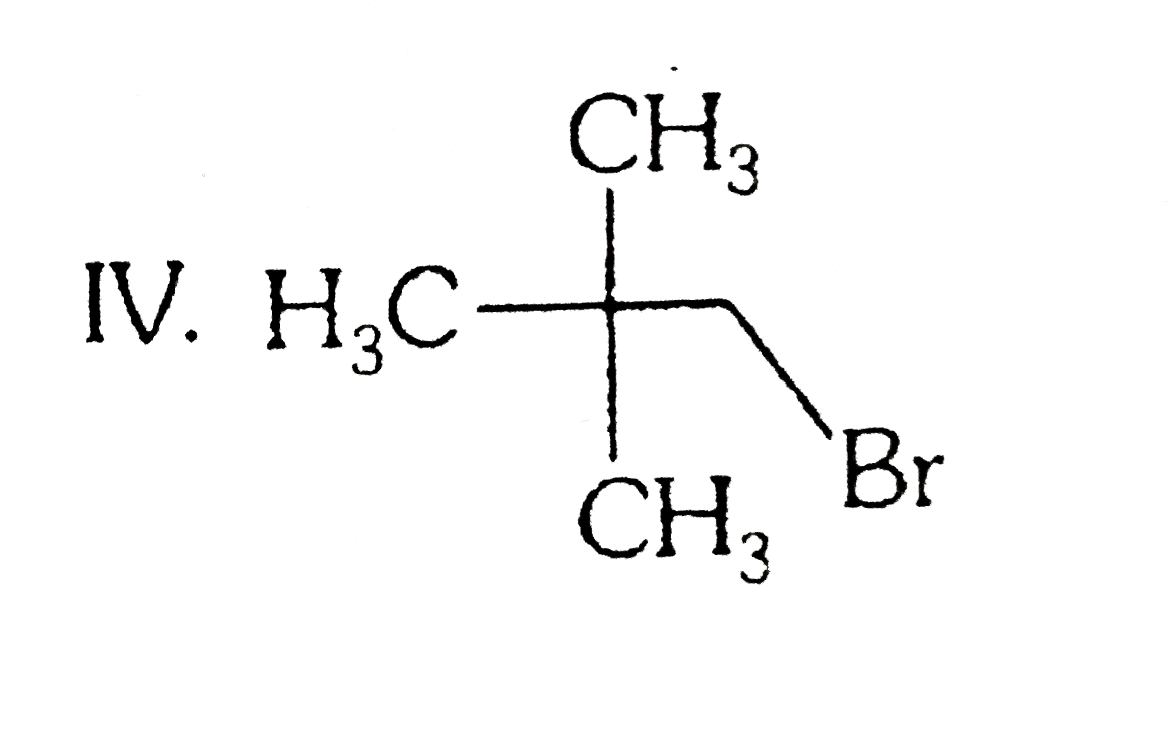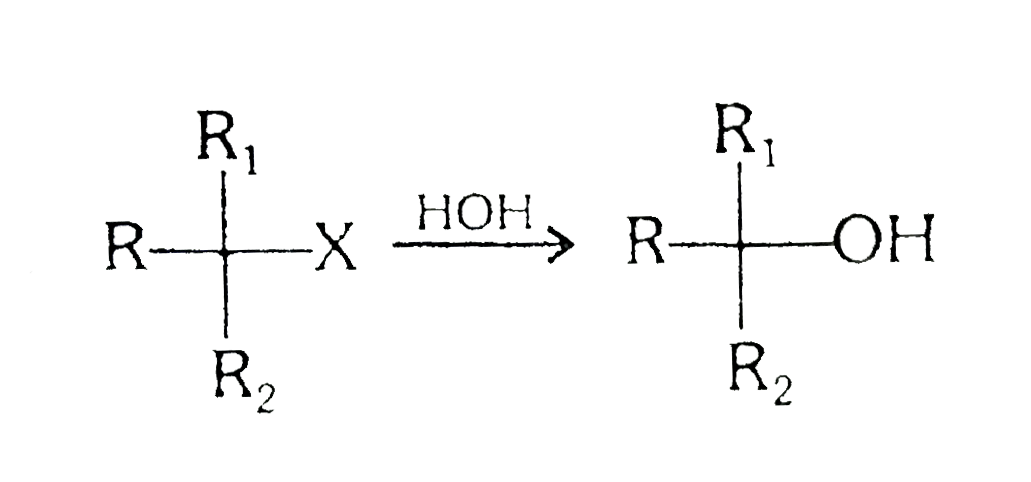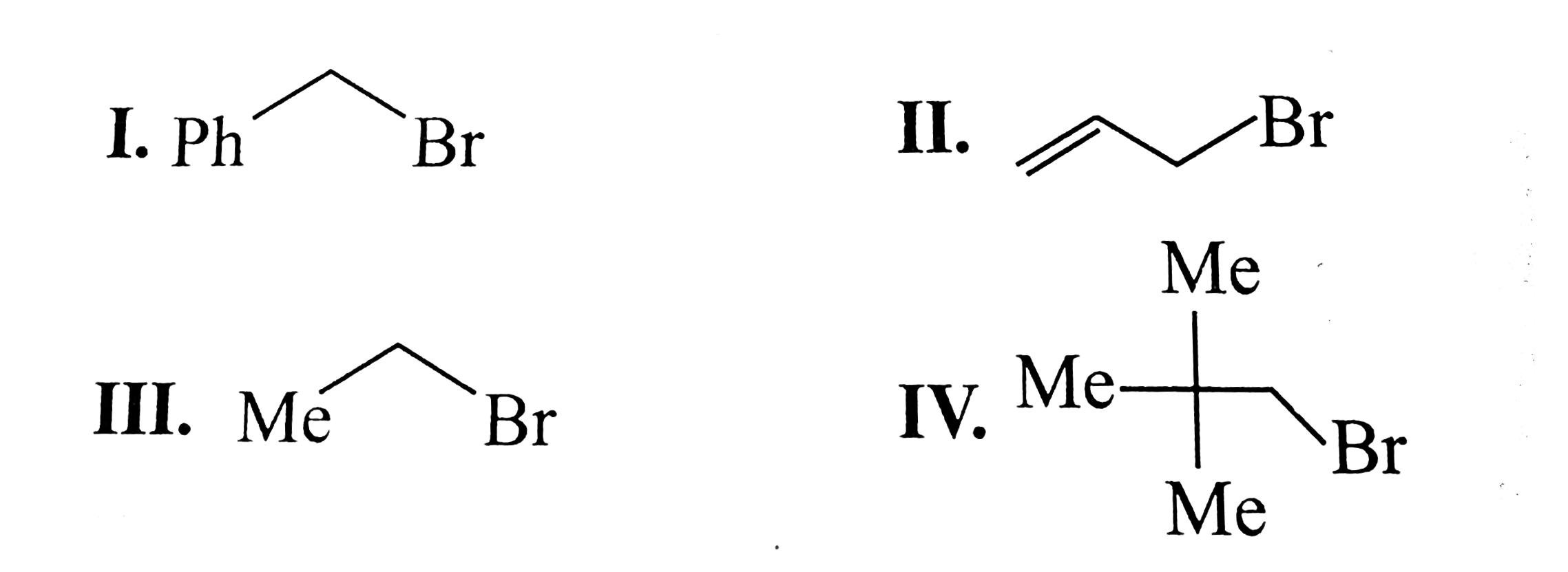Nucleophilic aliphatic substitution reaction is mainly of two types: SN1 and SN2. The SN1 mechanism is a two step process. Reaction velocity of SN1 reaction depends only on the concentration of the substrate. Since product formation takes place by the formation of carbocation, optically active substrate gives (+) and (-) forms of the product. In most of the cases the product usually consits of 5−20% inverted product and 80−95% racemised species. The more stable the carbocation, the greater is the proportion of racemisation. In solvolysis reaction, the more nucleophilic the solvent, the greater is the proportion of inversion.
Which one of the following compound will give SN1 reaction predominantly?


H3C−Br
All of these
The correct Answer is:A
To determine which compound will predominantly undergo the SN1 reaction, we need to analyze the stability of the carbocations formed from each compound. The SN1 mechanism involves the formation of a carbocation intermediate, and the stability of this carbocation is crucial for the reaction to proceed efficiently.
1. Understanding the SN1 Mechanism:
- The SN1 reaction is a two-step process where the first step involves the formation of a carbocation by the departure of the leaving group (in this case, a halide).
- The reaction rate depends only on the concentration of the substrate, not the nucleophile.
2. Carbocation Stability:
- The stability of carbocations follows this order:
- Tertiary (3°) > Secondary (2°) > Primary (1°) > Methyl.
- The more stable the carbocation, the more likely it is to form and thus favor the SN1 pathway.
3. Analyzing the Given Options:
- Let's denote the compounds as A, B, C, and D.
- We will analyze the carbocation that would form from each compound upon losing the leaving group (e.g., bromide).
4. Compound A:
- Upon losing the bromine atom, the carbocation formed is a tertiary carbocation with additional resonance stabilization due to the adjacent aromatic ring.
- This makes it highly stable.
5. Compound B:
- The carbocation formed here is a primary carbocation, which is significantly less stable than a tertiary carbocation.
6. Compound C:
- This compound forms a methyl carbocation, which is even less stable than a primary carbocation.
7. Compound D:
- This option states "all of these," but since we are looking for the compound that predominantly undergoes SN1, we need to choose the one that forms the most stable carbocation.
8. Conclusion:
- Among the options, Compound A forms the most stable carbocation (a tertiary carbocation with resonance), making it the compound that will predominantly undergo the SN1 reaction.
Final Answer:
The compound that will give SN1 reaction predominantly is Compound A.
- The SN1 reaction is a two-step process where the first step involves the formation of a carbocation by the departure of the leaving group (in this case, a halide).
- The reaction rate depends only on the concentration of the substrate, not the nucleophile.
- The stability of carbocations follows this order:
- Tertiary (3°) > Secondary (2°) > Primary (1°) > Methyl.
- The more stable the carbocation, the more likely it is to form and thus favor the SN1 pathway.
- Let's denote the compounds as A, B, C, and D.
- We will analyze the carbocation that would form from each compound upon losing the leaving group (e.g., bromide).
- Upon losing the bromine atom, the carbocation formed is a tertiary carbocation with additional resonance stabilization due to the adjacent aromatic ring.
- This makes it highly stable.
- The carbocation formed here is a primary carbocation, which is significantly less stable than a tertiary carbocation.
- This compound forms a methyl carbocation, which is even less stable than a primary carbocation.
- This option states "all of these," but since we are looking for the compound that predominantly undergoes SN1, we need to choose the one that forms the most stable carbocation.
- Among the options, Compound A forms the most stable carbocation (a tertiary carbocation with resonance), making it the compound that will predominantly undergo the SN1 reaction.
The compound that will give SN1 reaction predominantly is Compound A.
Topper's Solved these Questions
- ALKYL AND ARYL HALIDEBOOK - ALLENCHAPTER - ALKYL AND ARYL HALIDEEXERCISE - EXERCISE-02
1 Videos
- ALKYL AND ARYL HALIDEBOOK - ALLENCHAPTER - ALKYL AND ARYL HALIDEEXERCISE - EXERCISE-04 [A]
1 Videos
- ALKYL AND ARYL HALIDEBOOK - ALLENCHAPTER - ALKYL AND ARYL HALIDEEXERCISE - EXERCISE-01
1 Videos
- ALKENE, ALKANE & ALKYNE BOOK - ALLENCHAPTER - ALKENE, ALKANE & ALKYNE EXERCISE - EXCERSISE-3
28 Videos
- Atomic StructureBOOK - ALLENCHAPTER - Atomic StructureEXERCISE - All Questions
62 Videos
Similar Questions
Nucleophilic aliphatic substitution reaction is mainly of two types: SN1 and SN2. The SN1 mechanism is a two step process. Reaction velocity of SN1 reaction depends only on the concentration of the substrate. Since product formation takes place by the formation of carbocation, optically active substrate gives (+) and (-) forms of the product. In most of the cases the product usually consits of 5−20% inverted product and 80−95% racemised species. The more stable the carbocation, the greater is the proportion of racemisation. In solvolysis reaction, the more nucleophilic the solvent, the greater is the proportion of inversion.
Which of the following compounds will give SN1 and SN2 reactions with considerable rate?
I. C6H5−CH2−Br (II) CH2=CH−CH2−Br (III) CH3−CH(Br)CH3 (IV)
Select the correct answer from teh codes given below
View SolutionNucleophilic aliphatic substitution reaction is mainly of two types: SN1 and SN2. The SN1 mechanism is a two step process. Reaction velocity of SN1 reaction depends only on the concentration of the substrate. Since product formation takes place by the formation of carbocation, optically active substrate gives (+) and (-) forms of the product. In most of the cases the product usually consits of 5−20% inverted product and 80−95% racemised species. The more stable the carbocation, the greater is the proportion of racemisation. In solvolysis reaction, the more nucleophilic the solvent, the greater is the proportion of inversion.
For the gives reaction,
Which substrate will give maximum racemisation?
View Solution
Knowledge Check
Which of the following compounds will give SN1 reaction?
AH3C−CH2−BrB CH3C−⋅⋅O⋅⋅−CH2−ClD
CH3C−⋅⋅O⋅⋅−CH2−ClD
Rate of SN1 reaction is :
 AS>Q>R>PBS>R>P>QCP>Q>R>SDS>R>Q>P
AS>Q>R>PBS>R>P>QCP>Q>R>SDS>R>Q>PWhich of the following compounds will give racemic mixture by SN1 reaction?
A B
B C
C DH3C−CH∣CH2−Br−CH3
DH3C−CH∣CH2−Br−CH3
SN reaction is given by these compounds, which have a nuclophilic group and a good leaving EWG. It should be stable after leaving with bonding pair of ¯e's and it should have high polarisability.
Nucliphilic aliphatic substituion reaction is mainly of two types SN−1 and SN2.SN−1 mechanism is a two step process. Reaction velocity of SN−1 depends only on the concentration of the subtrate. It proceeds via the formation of carbocation, optically active substrate gives (⊕) and (o−) froms of the product.
In most of the cases, the product usually consists of 5−20% inverted and (95−80%) racemised species. The more stable is the carbocation, the greater is the propotion of racemission. In solvolysis reaction, the more nucleophillic is the solvent, the greater is the proportion of inversion.
Which of the following gives SN1 reaction?
View SolutionSN reaction is given by these compounds, which have a nuclophilic group and a good leaving EWG. It should be stable after leaving with bonding pair of ¯e's and it should have high polarisability.
Nucliphilic aliphatic substituion reaction is mainly of two types SN−1 and SN2.SN−1 mechanism is a two step process. Reaction velocity of SN−1 depends only on the concentration of the subtrate. It proceeds via the formation of carbocation, optically active substrate gives (⊕) and (o−) froms of the product.
In most of the cases, the product usually consists of 5−20% inverted and (95−80%) racemised species. The more stable is the carbocation, the greater is the propotion of racemission. In solvolysis reaction, the more nucleophillic is the solvent, the greater is the proportion of inversion.
Which of the following will give SN reaction?
View SolutionSN reaction is given by these compounds, which have a nuclophilic group and a good leaving EWG. It should be stable after leaving with bonding pair of ¯e's and it should have high polarisability.
Nucliphilic aliphatic substituion reaction is mainly of two types SN−1 and SN2.SN−1 mechanism is a two step process. Reaction velocity of SN−1 depends only on the concentration of the subtrate. It proceeds via the formation of carbocation, optically active substrate gives (⊕) and (o−) froms of the product.
In most of the cases, the product usually consists of 5−20% inverted and (95−80%) racemised species. The more stable is the carbocation, the greater is the propotion of racemission. In solvolysis reaction, the more nucleophillic is the solvent, the greater is the proportion of inversion.
Which of the following gives SN1 reaction?

Select the correct answer.
View SolutionSN reaction is given by these compounds, which have a nuclophilic group and a good leaving EWG. It should be stable after leaving with bonding pair of ¯e's and it should have high polarisability.
Nucliphilic aliphatic substituion reaction is mainly of two types SN−1 and SN2.SN−1 mechanism is a two step process. Reaction velocity of SN−1 depends only on the concentration of the subtrate. It proceeds via the formation of carbocation, optically active substrate gives (⊕) and (o−) froms of the product.
In most of the cases, the product usually consists of 5−20% inverted and (95−80%) racemised species. The more stable is the carbocation, the greater is the propotion of racemisation. In solvolysis reaction, the more nucleophillic is the solvent, the greater is the proportion of inversion.
For the reaction

which substrate will give maximum racemismision ?
View Solution
Which of the following products can be obtained by SN1 reaction?
View Solution
